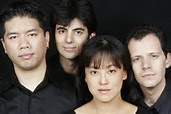Debussy masterpieces anchor new discs by Frederic Chiu and the Avalon String Quartet
Paul Rosenfeld, an insightful if excessively florid music critic of the early 20th century, was in full cry when he turned his attention to Claude Debussy. From various sources, there is a host of picturesque writing about the French master (1862-1918). His music is forever linked to impressionism but he was more comfortable with the designation "realism," as Frederic Chiu usefully reminds us in notes for his Debussy centered CD, "Distant Voices." Rosenfeld was swept away by the music, whatever label better applies to it.
 |
| Frederic Chiu partners Debussy with Gao Ping |
"The Quartet is alive, quivering with light, and with joyous animality," Rosenfeld wrote. "It moves like a young fawn; spins the gayest, most silken, most golden of spider webs; fills one with the delights of taste and smell and sight and touch."
Why write about one way a piece of music strikes you when you can write about several ways it does so all at once? This is the Rosenfeld procedure, and, prophetically, it applies perfectly to the way the Avalon String Quartet plays the work in its new recording, "Illuminations" (Cedille Records). What is most impressive is the sense of movement, on that animal level that Rosenfeld praised.
 |
| Leading off with classic Debussy, the Avalon Quartet (violinists Blaise Magniere and Marie Wang, violist Anthony Devroye, and cellist Cheng-Hou Lee) spotlights fellow Chicagoan Stacy Garrop. |
Rosenfeld's fawn may call up an image of the sound-alike creature that's the subject of Debussy's most famous piece, "Prelude to the Afternoon of a Faun." But the string quartet's woodland creature is the immature deer Rosenfeld had in mind.
In the Avalon's performance you can feel the sinews of life, the twitch of muscle beneath the skin. This is the most rhythmically acute, the leanest and most alert, account of the piece I've heard. In urban terms, the Avaloners give some street cred back to the Debussy quartet.
Some other ensembles choose, so it seems, to stress the latter part of Rosenfeld's description. Indeed, quite a bit of Debussy's music evokes the atmosphere suggested by those golden, silken spider webs.
Examples might include the Debussy "hit," "Clair de Lune," which with "Reverie" makes a kind of coda to Chiu's fascinating recording. And, of course, "Reflets dans l'eau" (from "Images") and "Jardins sous la pluie" (from "Estampes"), also evoke delicate imagery, despite strong appeals (synesthetically) to all the senses.
Chiu's performances are strikingly colored, assertive while being fully within the Debussy idiom. Both books of "Images" are presented, as well as two pieces from "Estampes."
They complement the oddly more demanding works of Gao Ping. That's not to say there's anything easy about Debussy's piano music, particularly teh sort of brilliant performance as Chiu gives to "Mouvement," the last of Volume 1 of "Images") Those that call for "vocalizing pianist" must evoke a non-artistic use of the voice, applied as if out of impulse. The three Gao Ping for piano alone display his sparse, 21st-century impressionism of a distinctive kind, as well as his Russian-inspired motoric energy and coruscating flair. (A well-directed, visually informative DVD of the program is part of the issue.)
Also on the Avalon disc is the title piece, a nine-movement evocation of the Book of Hours, an illuminated manuscript of the 15th century, a cycle of daily devotions for Duchess Catherine of Cleves. **The composer, Stacy Garrop, seeks to bring the listener close to the experience of turning the book's beautiful pages.
There is a good deal of expressive variety in her settings, which are inspired (the notes say) by the familiar "Pictures at an Exhibition" (Mussorgsky). That suite's famously detailed translations into musical terms of images that are hardly in anyone's consciousness when the Russian work is performed are a worthy model. Garrop's piece opens up the rarely seen treasures of this book in ways that draw the listener in, whether the subject is "Singing Angels" or "Christ Carrying the Cross."
The other work on the disc with a religious cast to it is Osvaldo Golijov's "Tenebrae," which I found kind of vacuous in comparison. What remains are four charming short works by Benjamin Britten, character pieces titled Three Divertimenti plus the straightforward "Alla Marcia."



Comments
Post a Comment